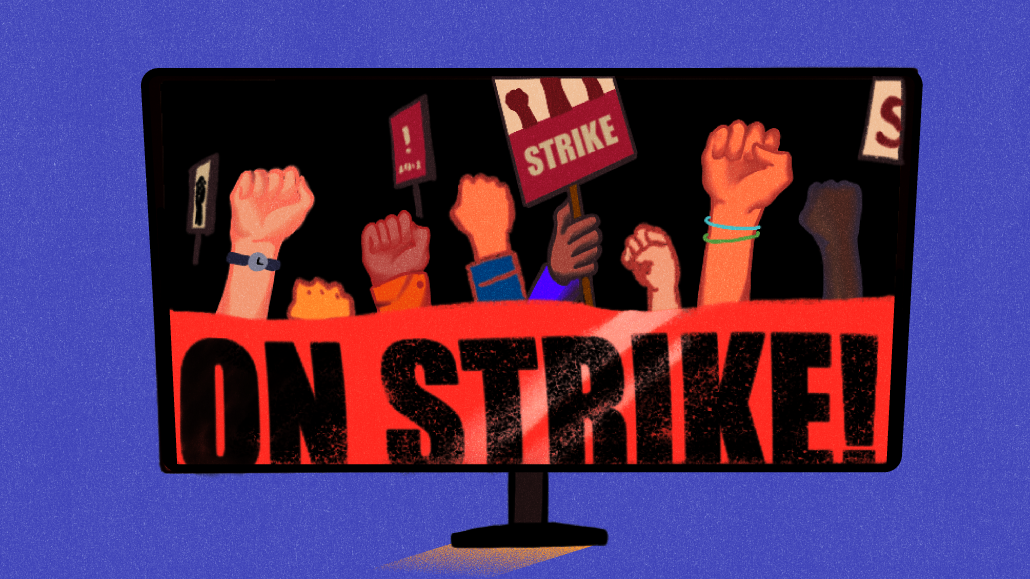Save 50% on a 3-month Digiday+ membership. Ends Dec 5.
Here is the impact of newsroom union strikes on publisher traffic and published articles

The media industry has been hit with a devastating wave of layoffs in the past month, from the Los Angeles Times to Condé Nast. Newsroom unions have organized work stoppages and walkouts in an effort to show company managers how valuable their labor is, but what’s the impact of their actions?
Digiday looked at traffic data from Similarweb and published article count data from Muck Rack to find out.
Five media company unions organized work stoppages in the past month, with hundreds of staff walking off the job for one to three days. Condé Nast, the New York Daily News, The Los Angeles Times and The Washington Post all had 24-hour work stoppages organized by their newsroom unions, while Forbes had a three-day walkout that ended on Monday.
The number of articles published on those sites during the work stoppages dipped, compared to the same time periods a week prior, but traffic appears to have been less directly impacted. Unique visitors (in the U.S. and worldwide) on desktop and mobile web to Condé Nast titles, the LA Times and The Washington Post all fell during those walkouts, but actually went up at Forbes and the New York Daily News.
Condé Nast and The LA Times declined to comment. The New York Daily News and The Washington Post did not respond to requests for comment before publishing time.
A Forbes spokesperson told Digiday, “Forbes continued to serve its audiences and publish its content across platforms during this time.”
Susan DeCarava, president of the NewsGuild of New York, said the goal of these newsroom union actions is to show employers that the employees’ labor is what helps those companies run and generate revenue (the NewsGuild of NY represents the unions of all of the companies in this story other than the L.A. Times, which is represented by the NewsGuild-CWA). When asked how much revenue was impacted by these strikes, NewsGuild unions could not give Digiday a figure.
Ad position: web_incontent_pos1
And in the cases where traffic wasn’t impacted by the work stoppages, DeCarava said some outlets relied on evergreen or aggregated content to make up what was lost when journalists walked away from their desks. Also, week-over-week comparisons of site traffic and the number of published articles can be subject to variables unrelated to the union strikes, such as slower news cycles. And site traffic on the days before and after the strikes followed similar trends to the data below.
DeCarava said media companies can expect more walkouts to come this year.
“Frankly, the more that companies attempt to increase their profit margins… off the backs of the people who are actually doing the work, the more they’re going to see this type of escalating labor unrest,” she said.
The data is below:
Condé Nast
Ad position: web_incontent_pos2
SimilarWeb analyzed unique visitors to Condé Nast titles including the New Yorker, Wired, Vogue, Bon Appetit, Vanity Fair, GQ, Glamour, Pitchfork, Architectural Digest and CN Traveler.
On the day of Condé Nast union’s strike on Jan. 23, worldwide traffic to those titles was 4.3 million and U.S. traffic was 2.7 million. That was down from 4.5 million visitors worldwide and 2.9 million visitors in the U.S. on Jan. 16, the same day a week prior.
As for the published article count for Condé Nast’s U.S. titles, 143 articles were published on those sites on Jan. 23, down from 179 articles on Jan. 16.
Forbes
Forbes’ union went on strike on Jan. 25, 26 and 29. On Jan. 25 and 26 (Similarweb did not have data for Jan. 29), worldwide traffic was 4.6 million and 4.2 million, respectively, while U.S. traffic was 2.9 million and 2.7 million on those dates. This was an increase of site visitors compared to the same days a week prior, up from 4 million and 3.9 million worldwide and 2.6 million and 2.5 million in the U.S. on Jan. 18 and 19, respectively.
Forbes published a total of 881 articles for the three days of the work stoppage, compared to 933 articles on the same three days in the prior week.
New York Daily News
On Jan. 25, worldwide traffic was about 300,000 worldwide and U.S. traffic was 257,000. This was also an increase from the week prior, up from 288,000 worldwide site visitors and 236,000 U.S. visitors on Jan. 18.
The New York Daily News published 93 articles on Jan. 25, down from 145 articles on Jan. 18.
The LA Times
On Jan. 19, worldwide traffic to The LA Times’ site was 1.3 million and U.S. traffic was 1 million. That was a decrease from 1.4 million worldwide visitors and 1.2 million U.S. visitors on Jan. 12.
The LA Times published 123 articles on Jan. 19, compared to 146 articles on Jan. 12.
The Washington Post
On Dec. 7, worldwide traffic to The Washington Post was 4.6 million, down from 4.8 million site visitors on Nov. 30.
The Washington Post published 382 articles on Dec. 7, compared to 536 articles published on Nov. 30.
More in Media

What publishers are wishing for this holiday season: End AI scraping and determine AI-powered audience value
Publishers want a fair, structured, regulated AI environment and they also want to define what the next decade of audience metrics looks like.

Digiday+ Research Subscription Index 2025: Subscription strategies from Bloomberg, The New York Times, Vox and others
Digiday’s third annual Subscription Index examines and measures publishers’ subscription strategies to identify common approaches and key tactics among Bloomberg, The New York Times, Vox and others.

From lawsuits to lobbying: How publishers are fighting AI
We may be closing out 2025, but publishers aren’t retreating from the battle of AI search — some are escalating it, and they expect the fight to stretch deep into 2026.
Ad position: web_bfu




